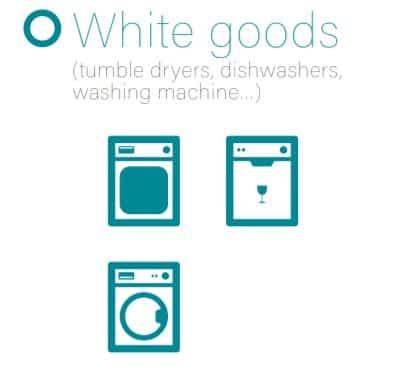
10 Dec The role of brominated flame retardants in electric and electronic appliances
Fire spreads rapidly: escape time is limited
According to the US Department of Homeland Security a fire can become life-threatening in just 2 minutes. It takes no more than 30 seconds for a small flame to burst into a sizable fire. It is clear that when you are trying to escape a fire, every second counts.
Accidental fires can start easily by many different reasons: for example gas stoves, burning cigarettes, failing electronics … We all use highly flammable materials in our homes, workspaces and public places on a daily basis, but we might not be aware of the risks they present.
These materials are especially flammable:
- Electrical appliances and electronics
- Synthetics and fibres such as upholstered furniture, carpets, wall coverings and drapery
- Insulation material
The impact of our electronics addiction on fire safety
Over time more and more of these materials have become commonplace for all of us. We rely on them in every aspect of our lives. That is especially the case with electrical appliances and electronics. Our dependency on electronics has indeed increased our level of comfort and made our lives easier, but in the same time it decreased fire safety in our homes, offices, factories, public places …
How? All kinds of electronics contain a high level of plastics, or polymers. These plastics present a significant fire risk.
The figures are clear, yet alarming:
The time available to escape from a burning building shortened drastically from 17 minutes in the 70s to even less than 3 minutes in 2015. Taking into account the pace of digital evolution, we will be seeing even more electronics in the future – everywhere. Does this mean that in a few years’ time, trying to escape from a burning building will be futile? Do we have to … embrace our horrible faith in the event of fire?
Luckily, it won’t go this far if we make use of brominated flame retardants. They make it possible to avoid or slow down the burning process, extending escape time and improving your chances of getting out safely.
Why are flame retardants so important?
Flame retardants are chemicals that are added to materials to slow down the ignition process in case of a fire. In that way they reduce risks of fire, property losses and – more importantly – human casualties.
Guillermo Rein is a Professor of Fire Science at the Department of Mechanical Engineering at Imperial College London. For our previous newsletter we had an interesting talk with him about fire science and the importance of flame retardants in society. He states that adding flame retardants to plastics ‘is the most successful way that we have right now to use plastics’.
Bromine reduces fire risk in electronics
As we already pointed out, electronics and electrical appliances, such as televisions, computers, radios, fridges and washing machines mostly consist of a high volume of plastics, which are highly flammable. Ignition may be initiated from both inside the device and from external sources.
Adding brominated flame retardants to these materials helps them meet safety standards and protect their users, since they prevent ignition from inside and out. Professor Rein agrees that bromine is a vital element for fire safety: ‘(…) I see bromine as something that helps make plastics less flammable. It has a significant amount of abilities to really decrease flammability, and for me that is absolutely essential’.
Where are brominated flame retardants used?



Brominated flame retardants are being added in appliances’ manufacturing process:
- they can either be added when manufacturing the polymer materials, or
- when manufacturing the printed circuit boards, in which case they react with materials such as epoxy.
Ban on halogenated flame retardants in electronic display
The European Commission adopted a ban on halogenated flame retardants, which include brominated flame retardants, in the Ecodesign Directive’s requirements for electronic displays on 1 October.
Unheard of, says BSEF. This ban goes beyond the scope of the Ecodesign Directive and subordinates RoHS, which should be the vehicle for any substance restrictions such as this one.
Brominated flame retardants are recyclable
The ban is being justified by the EC by stating that these halogenated flame retardants prevent WEEE plastics from being recycled. Well, this is not the case for the entire group of halogenated flame retardants.
BSEF, along with the plastics industry and recyclers are (and will be in the future) working on new technologies to address recycling properly. For many years now, it has been possible to recycle products containing brominated flame retardants. In fact, recycled plastics with brominated fire retardants in them, meet the same levels of fire safety as virgin material. No value is lost in the recycling process.
In case recycling a particular product is not possible, we have provided a number of eco-efficient waste management options:
- incineration with energy recovery,
- precious metals melting, or
- chemical recycling, which even allows the bromine to re-enter the circular economy as valuable resource.
Read more about BSEF’s take on this ban in our press release: BSEF objects to ban on halogenated flame retardants in EU ecodesign requirements for electronic displays.
Want to know more about flame retardancy?
Intrigued about the importance of fire safety and flame retardancy?
Professor Masaru Kitano of the Shukutoku University in Japan brought together his experiences, thoughts and views on fire safety and flame retardancy science in his book ‘Introduction to flame retardancy – Protect your life and property from fire’, and BSEF is proud to have worked on the translation of his book.
It is a highly fascinating book that applies to every one of us, since fire safety also affects every one of us. Read more about it: ‘Introduction to flame retardancy: the book’.

Want your exclusive copy of ‘Introduction to flame retardancy’?
Professor Kitano’s book is not for sale. If you are interested in reading it, please contact us and we will be happy to send you an exclusive copy!
Send your request to letstalkbromine@bsef.org.
SOURCES
https://lets-talk-bromine.bsef.com/2018/03/08/response-dr-alexander-morgan-flame-retardants-uk-furniture-increase-smoke-toxicity-reduce-fire-growth-rate-chemosphere-2018-196-429-439/
https://www.flameretardants.eu
https://lets-talk-bromine.bsef.com/2017/12/07/the-evolution-of-bromine-flame-retardants-towards-brominated-polymers/
https://www.bsef.com/fire-safety/
https://www.ready.gov/home-fires
https://lets-talk-bromine.bsef.com/2017/12/07/the-evolution-of-bromine-flame-retardants-towards-brominated-polymers/
https://chemicalwatch.com/82803/industry-blasts-eu-ban-on-halogenated-flame-retardants-in-electronic-displays#overlay-strip
https://chemicalwatch.com/75831/ecodesign-directives-proposed-halogens-ban-not-a-precedent-eu-says#overlay-strip
https://pr.euractiv.com/pr/proposed-eu-eco-design-regulation-electronic-displays-ban-halogenated-flame-retardants-casings




No Comments